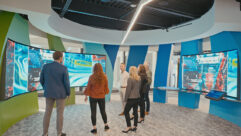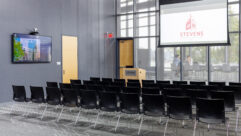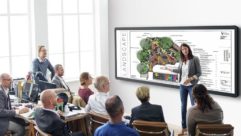
Installation Profile:
Immersive Research
Feb 16, 2007 3:00 PM,
By Daniel Keller
LITE Digs Deeper with cutting-edge virtual reality projection technology.

LITE’s six-sided total immersive space uses Christie’s Mirage S+8K stereoscopic projectors and custom-developed 10’x10’ rear-projection display surfaces on all four walls, floor and ceiling. The environment provides an opportunity to study an unprecedented level of detail in objects that cannot normally be seen.
Lafayette, La., has become one of the Bayou’s high-tech beacons. Long a home to oil and gas exploration, the city’s emergence as a nexus for scientific research and development has fueled an unprecedented surge in population and economic growth, beginning even before the post-Hurricane Katrina mass migration to Lafayette from New Orleans.
The jewel in Lafayette’s crown is the recently launched Louisiana Immersive Technologies Enterprise (LITE), one of the world’s largest and most advanced 3D immersive visualization and supercomputing facilities. The $27 million, 70,000-square-foot complex — originally formed as a partnership among the state of Louisiana, the University of Louisiana at Lafayette, and the Lafayette Economic Development Authority (LEDA) — provides a state-of-the-art collaborative environment for a vast range of user communities in scientific research, higher education, government, and commercial industry. In July of 2006, Louisiana Governor Kathleen Blanco declared LITE a political subdivision of the state of Louisiana, making it a state entity governed by a board of commissioners.
“LITE was conceived with the mission of providing access to leading-edge virtual reality (VR) design and decision-making technologies,” says Dr. Carolina Cruz-Neira, LITE’s executive director and chief scientist. Cruz-Neira, whose doctoral studies at the University of Illinois at Chicago included the design of the CAVE virtual reality environment, a precursor to the LITE facility, has long been active in bringing virtual reality research to a wider audience.
“These types of data visualization tools were only previously available to large corporations,” she says. “Now, industry, government, and university sectors have access to essential technologies for collaborative research, application development, testing and validation, product development, and training.”
LEDA originally conceived the idea for a high-end VR research facility as a means of bringing industry and commerce to the area. The facility was intended to target firms in the area’s oil and gas, defense, and shipping industries.

Christie custom-designed an 11’x40’ curved screen for LITE’s 175-seat immersive auditorium.
“They reached out to these industries to ask what they would like to see in a facility of this type and made excellent use of that information in creating the LITE facility,” says Dave Fluegeman, vice president of visual environments at Christie Digital, the company behind the project’s display technology and its integration into the overall visual systems solution.
The LITE research complex offers a number of advanced immersion environments, including one of the world’s few six-sided, fully immersive rooms. The facility is powered by a massive SGI High Performance Computing (HPC) platform providing 4.1TB of memory and high-speed networking. In all, more than 1,000 SGI Altix processors are online, and any part of the facility can access the SGI platform’s processing power.
ASSEMBLY REQUIRED
Fluegeman says, “[Work on the year-and-a-half long project] varied between mildly intensive to very intensive. It was a complex endeavor from the outset, and required tight coordination of a wide range of aspects, from structural to technical and beyond. LEDA’s intent was to find a single technical vendor who could bring this all together.”
As part of a visual systems team led by James River Technical of Richmond, Va., Christie worked with SGI to take the raw requirements and plan for the installation even before ground was broken on the project.
As Fluegeman points out, the project was a natural fit for Christie. “Our flagship Mirage 3D platform was the first active stereo projector on the market,” he says, “dating back to the launch of Texas Instruments’ SXGA DLP chip around 2000, and we’ve led the way with purpose-built, VR-directed 3D projection. So it made sense for us to be involved with the LITE project.”
LITE’s most visible feature is a fully immersive, six-sided room environment. The custom-developed visual cube is comprised of 10’×10′ rear-projection display surfaces on all four walls, floor and ceiling, using Christie’s Mirage S+8K stereoscopic projectors. The cube itself sits at the second-floor level, with rear projection underneath, above, and on all four sides.

LITE’s 3D immersive visualization cube is the facility’s most recognizable structure.
“Six-sided environments like this one are pretty rare,” Fluegeman says. “The most common displays are three-sided ones — typically two walls and a ceiling or three sides. But when you get into six sides, it requires a significant leap in terms of research, in terms of the level of precision for engineering data, and in terms of computing power. Edge matching and synchronization in a six-sided environment like this is exceptionally complex.”
LITE’s 175-seat immersive auditorium also employs three Christie Mirage S+8K projectors, which can be run in active or passive stereo modes. Images from the projectors are blended onto an 11’×40′ curved screen custom-designed by Christie.
“The immersive theater’s curved screen gives the viewer a wide field of view and excellent depth perception, which provide a high-quality 3D experience,” Fluegeman explains.
“We have a 300,000-square-foot manufacturing facility in Kirchener, Ontario, where we can build and stage any type of visual display solution that we can design,” Fluegeman explains. “Both the six-sided immersive environment and the auditorium’s curved screen were created in our facility before they ever went up onsite, so we knew they would work.”
Christie also designed and implemented an integrated audio system for the auditorium, comprising two independent systems for program audio and presentation (speech reinforcement) applications. The program system is a 5.1 surround configuration with three JBL 4212 boxes covering LCR channels and four JBL 8330 speakers as rear channels. A single ASB4128 passive sub is flown in the center cluster to cover low-end content. The system is powered by QSC amplification, with Rane THX equalization.
The speech reinforcement system runs several Shure wired and wireless microphones through a Symetrix Symnet Express 8×8 processor, which feeds six zones of audio through a QSC CX108V amplifier to a total of 18 JBL26CT speakers distributed throughout the room.
Also included at the LITE facility is an immersive conference room — a lecture and presentation environment that features a large-scale 3D VR system with motion tracking; and the Immersive Collaboration Teleconference Room, which hosts up to 25 people and is designed to accommodate various tasks, including videoconferencing, and PowerPoint and other types of presentations.

LITE’s 175-seat immersive auditorium features a custom 11’x40’ curved screen designed to improve the 3D experience by providing the viewer with a wide field of view and excellent depth perception. Images from three Christie Mirage S+8K projectors, which can be run in active or passive stereo modes, are blended onto the curved screen.
The conference room uses a pair of Tandberg Wave II PTZ cameras with wide-angle lenses, connecting through an IP-based Tandberg 6000 MXP codec. This configuration allows local users to choose which video feed they want the far-end users to view. The conference room’s audio is wireless, using four deployable Shure boundary mics for easy reconfiguration. Mic outputs are sent to a Mackie 1202-VLZ Pro mixer, which feeds the Tandberg codec and a TOA A-912MK2 distributed audio amp in the Christie AV rack. Six JBL Control 24 ceiling speakers provide audio to the room.
WHO NEEDS VR?
Although much of the general public may still identify virtual reality with video gaming, for a growing number of people in a wide range of industries, VR is no longer a toy. Mission-critical applications of immersion technology provide a unique facility for displaying levels of detail in real-world objects that cannot normally be seen, such as molecular structures, air and fluid dynamics, and weather patterns, creating a strong demand in sectors like oil and gas research, and automotive and aerospace design. Strong new markets are emerging in medical research, nano-technology, law enforcement, and other fields, as well.
“We’re seeing quite a bit of interest from FEMA and the National Corps of Engineers, who are looking into utilizing 3D research in rebuilding the coastal areas [ravaged by Hurricane Katrina],” Cruz-Neira says. “Structural research of this type can have a major impact on the integrity of the levees, and VR technology can play an important role not only in rebuilding the area, but in protecting against future disasters.”
The automobile industry, too, has moved to large-scale immersive projection systems for design creation and evaluation, according to Cruz-Neira.
“The cars most of us drive today have been designed using these technologies,” she says. “The VR environment makes testing and analysis much easier to document, and number crunching far more useful. In many cases, it’s simply not practical to do real-world testing. For example, in safety testing — aside from the obvious fact that you can’t use real humans in applications like impact tests, it would be prohibitively expensive to build real prototype models for every phase of evaluation in design.”
Fluegeman agrees. “Look at the tremendous pressure within the auto industry, and the competitive nature of getting a new model to market,” he says. “Their development cycle has been cut in half over the past decade. For automobile and aerospace manufacturers, wind tunnels are a thing of the past. Testing for attributes like wind resistance, structural design, and stress is far more accurate in the virtual domain than it is with a clay model, and the results of that data are more easily analyzed.”

LITE’s total immersive space sits at the second-floor level, with rear projection underneath, above, and on all four sides. The environment uses advanced visualization techniques that immerse the subject in a 3D space using high-speed presentation of left-eye, right-eye data by the physical projector.
Cruz-Neira notes that VR technology has evolved in different directions to meet the needs of different users.
“The degree of realism required, and the focus of that realism, is entirely dependent on the application,” she says.
CREATING THE VISION
As Fluegeman explains, the dynamics of creating visual environments fall into different categories. “Advanced visualization provides an artificial reality that projects, or immerses the subject into a 3D space,” he says. “This technology is well suited for R&D applications where a real-world environment is useful — for example, bringing perspective to CAD drawings. In advanced visualization, the physical projector creates the representation of 3D by way of very high-speed presentation of left-eye, right-eye data.
“Simulation, or computer modeling, [involves] lifelike modeling of an object or process, and is useful in a wide range of applications, including flight training and the modeling of natural systems in medical and biological applications. In simulation, the computer is drawing everything in 3D as you look at it, rendering millions and millions of polygons and essentially moving through a scene of terrain in realtime. It’s an immense amount of processing.
Fluegeman says that both technologies rely on Christie projectors to represent the fields of color and image accurately, and to warp and bend the image to types of screens that provide the viewer with the necessary depth of field to make them feel that they’re actually in a real aircraft, for example. “It’s a level of resolution that’s unattainable with a flatscreen in someone’s game room,” he says.
“The science of VR has been around for several decades, but new technologies in image rendering and projection are always being developed, and Christie has always been active in that development,” Fluegeman says. “We’ve developed a projector that is very specific to the demands of simulation. We’ve also developed projectors that respond to the 3D-visualization requirements of engineering or R&D groups. We can apply our technology into multiple immersive visualization markets and provide purpose-engineered products and purpose-designed solutions that fit to each. We refer to it as our TotalView technology. … We’re creating turnkey solutions to meet the needs of industries using 3D representation of engineering data.”
EXPANDING HORIZONS
The LITE complex formally opened its doors in September 2006 in a ceremony presided over by Governor Blanco and Commissioner of Administration Jerry Luke LeBlanc. As Fluegeman observes, the growing popularity of 3D immersion technologies has created interest from a widening range of prospective clients.
“We’re seeing a whole new generation of potential users for 3D technologies,” he says. “As the raw costs of production come down, the quality of resolution continues to improve, not only in graphics boards themselves but also in our ability to display them. The cost of entry now appeals to a whole new level of user, and we’re beginning to see a transition, where industries for whom this technology has traditionally been out of reach are sitting up and taking notice.
“The growth of VR technology is not just good for those of us in the industry. It’s good for society overall. Greater precision in production has a major impact on so many interconnected aspects of our culture.”
For More Information
Christie
www.christiedigital.com
Mackie
www.mackie.com
Rane
www.rane.com
SGI
www.sgi.com
Shure
www.shure.com
Symetrix
www.symnetaudio.com
Tandberg
www.tandberg.net
TOA Electronics
www.toaelectronics.com
Daniel Kelleris an audio industry veteran and principal of Get It In Writing.










